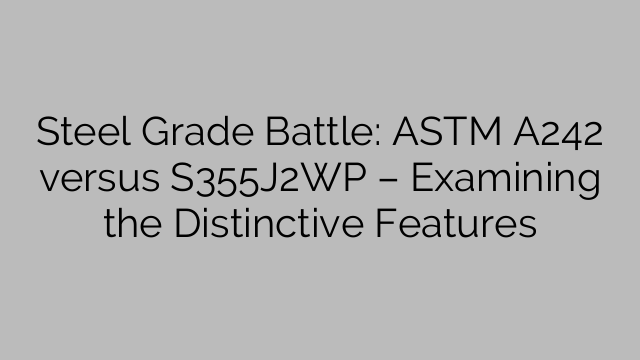Steel Grade Battle: ASTM A242 versus S355J2WP – Examining the Distinctive Features
When it comes to building materials, steel is undoubtedly one of the most widely used and versatile choices. Within the realm of steel, various grades exist, each possessing unique characteristics that make them suitable for different applications. In this article, we will be focusing on a battle of two grades: ASTM A242 and S355J2WP, examining their distinctive features and exploring their respective uses.
ASTM A242, also known as weathering steel, is a low-alloy structural steel renowned for its high atmospheric corrosion resistance. This steel grade is primarily used in outdoor applications such as bridges, buildings, and other structures exposed to the elements. The unique feature of ASTM A242 is its ability to develop a protective oxide layer, known as patina, when exposed to the atmosphere. This patina not only prevents the steel from further corrosion but also adds an aesthetic appeal to the structure.
On the other hand, we have S355J2WP, a structural steel grade that is also known for its corrosion resistance. It is particularly suitable for applications where exposure to harsh weather conditions is a concern. S355J2WP is widely used in construction industries, especially in areas with a high risk of corrosion such as coastal regions. It offers excellent resistance against atmospheric corrosion, making it a popular choice for outdoor infrastructure projects.
While both ASTM A242 and S355J2WP excel in terms of corrosion resistance, there are some distinctive differences worth noting. One of the key differences lies in their chemical compositions. ASTM A242 primarily consists of copper, chromium, nickel, and phosphorus, whereas S355J2WP contains copper, chromium, nickel, and a higher percentage of phosphorus. The differences in chemical composition contribute to the variation in their corrosion resistance properties.
Furthermore, the mechanical properties of these two grades exhibit disparities. ASTM A242 has higher yield and tensile strength compared to S355J2WP. It offers better structural integrity, making it suitable for demanding applications that require high strength and durability. S355J2WP, on the other hand, has slightly lower strength properties, but it compensates for this with its enhanced atmospheric corrosion resistance.
When it comes to cost, ASTM A242 tends to be more expensive compared to S355J2WP. This is primarily due to its higher alloy content and superior corrosion resistance properties. However, considering the long-term benefits of using weathering steel, the initial investment is often outweighed by the reduced maintenance costs and prolonged lifespan of the structure.
In conclusion, both ASTM A242 and S355J2WP are exceptional steel grades with their own distinctive features. ASTM A242 is renowned for its high atmospheric corrosion resistance and ability to develop a protective oxide layer, while S355J2WP offers excellent resistance against atmospheric corrosion. Each grade is ideal for specific applications and should be chosen based on the desired strength, corrosion resistance, and budget. Ultimately, understanding the distinctive features of these steel grades enables engineers and builders to make informed decisions and select the most suitable material for their projects.

